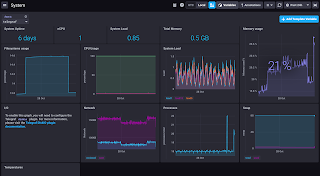Using A Telegraf Gateway
All my servers and sensors will be visualized in InfluxDB. They can all write directly into my local instance of InfluxDB OSS, but I also want to be able to write to remote instances, such as Influx Cloud. To do this, there are some limitations:
If I can collate all my updates into one place, all the adminitration of the points above goes away.
Therefore, having an interstitial instance of Telegraf, a Telegraf Gateway, is a good solution. I'll need to do some things:
So, I need to create a configuration for my telegraf gateway.
Telegraf reads default configurations from /etc/telegraf/telegraf.conf and /etc/telegraf/telegraf.d/filenames.conf, so let's create these:
/etc/telegraf/telegraf.conf
/etc/telegraf/telegraf.d/influxdb_listener.conf
/etc/telegraf/telegraf.d/socket_listener.conf
/etc/telegraf/telegraf.d/outut_influxdb.conf
As this is a LXC container, and I want to monitor all my containers, I should add a set of OS monitoring configurations. I shouldn't enable SMART monitoring or temperature monitoring, as those should come from the underlying server on which I'm running the container
/etc/telegraf/telegraf.d/cpu.conf
/etc/telegraf/telegraf.d/disk.conf
/etc/telegraf/telegraf.d/internal.conf
/etc/telegraf/telegraf.d/kernel.conf
/etc/telegraf/telegraf.d/mem.conf
/etc/telegraf/telegraf.d/net.conf
/etc/telegraf/telegraf.d/processes.conf
/etc/telegraf/telegraf.d/swap.conf
/etc/telegraf/telegraf.d/system.conf
So now Telegraf will write to all three of my outputs, collating data from all three of the types of input I have (Telegraf, HTTP custom endpoint, UDP).
This is what it looks like in Chronograf, showing a system view:
- Influx Cloud can only accept HTTP ingest. Any UDP messages will be dropped before they get through the Internet
- Usernames and passwords might change, so I will need to edit every Telegraf configuration file on every machine on my LAN
- Access tokens might change over time (especially as I migrate to Influx Cloud v2), so I will need to edit every Telegraf configuration file on every machine on my LAN
- Cloud services might be protected by IP address, so I might need to open multiple holes in firewalls.
- If I write to InfluxDB with anything other than Telegraf, I will need to worry about batching them myself, adding jitter to decrease the possibility of LAN overload, etc.
If I can collate all my updates into one place, all the adminitration of the points above goes away.
Therefore, having an interstitial instance of Telegraf, a Telegraf Gateway, is a good solution. I'll need to do some things:
- Install a container for Telegraf
- Enable telegraf inputs for UDP & HTTP
- Enable telegraf outputs for wherever I'll be writing my data
So, I need to create a configuration for my telegraf gateway.
Telegraf reads default configurations from /etc/telegraf/telegraf.conf and /etc/telegraf/telegraf.d/filenames.conf, so let's create these:
/etc/telegraf/telegraf.conf
[global_tags]
[agent]
interval = "10s"
round_interval = true
metric_batch_size = 1000
metric_buffer_limit = 10000
collection_jitter = "3s"
flush_interval = "10s"
flush_jitter = "5s"
precision = ""
debug = false
quiet = false
logfile = "/var/log/telegraf/telegraf.log"
logfile_rotation_interval = "0d"
logfile_rotation_max_size = "1MB"
logfile_rotation_max_archives = 5
hostname = ""
/etc/telegraf/telegraf.d/influxdb_listener.conf
# Influx HTTP write listener
[[inputs.influxdb_listener]]
service_address = ":8086"
read_timeout = "10s"
write_timeout = "10s"
max_body_size = "500MiB"
max_line_size = "64KiB"
database_tag = "bucket_name"
/etc/telegraf/telegraf.d/socket_listener.conf
[[inputs.socket_listener]]
service_address = "udp://:8089"
/etc/telegraf/telegraf.d/outut_influxdb.conf
# Local InfluxDB
[[outputs.influxdb]]
urls = ["http://ip_address_of_local_InfluxDB_server:8086"]
database_tag = "bucket_name"
exclude_database_tag = true
# SE Cloud
[[outputs.influxdb]]
urls = ["https://FQDN_of_Influx_Cloud:8086"]
database = "database_name_to_write_to"
username = "my_username"
password = "my_password"
timeout = "30s"
# Cloud 2 instance
[[outputs.influxdb_v2]]
urls = ["https://FQDN_of_Influx_Cloud_2"]
token = "The_Token_Generated_within_Influx_Cloud_2"
organization = "my_registered_email_address_on_Influx_Cloud_2"
bucket = "my_bucket_to_write_to"
As this is a LXC container, and I want to monitor all my containers, I should add a set of OS monitoring configurations. I shouldn't enable SMART monitoring or temperature monitoring, as those should come from the underlying server on which I'm running the container
/etc/telegraf/telegraf.d/cpu.conf
# Read metrics about disk usage by mount point
# Read metrics about cpu usage
[[inputs.cpu]]
## Whether to report per-cpu stats or not
percpu = true
## Whether to report total system cpu stats or not
totalcpu = true
## If true, collect raw CPU time metrics.
collect_cpu_time = false
## If true, compute and report the sum of all non-idle CPU states.
report_active = false
/etc/telegraf/telegraf.d/disk.conf
# Read metrics about disk usage by mount point
[[inputs.disk]]
ignore_fs = ["tmpfs", "devtmpfs", "devfs", "iso9660", "overlay", "aufs", "squashfs"]
# Read metrics about disk IO by device
[[inputs.diskio]]
/etc/telegraf/telegraf.d/internal.conf
# Collect statistics about itself
[[inputs.internal]]
## If true, collect telegraf memory stats.
collect_memstats = true
/etc/telegraf/telegraf.d/kernel.conf
[[inputs.kernel]]
# no configuration
/etc/telegraf/telegraf.d/mem.conf
# Read metrics about memory usage
[[inputs.mem]]
# no configuration
/etc/telegraf/telegraf.d/net.conf
# Read metrics about network interface usage
[[inputs.net]]
/etc/telegraf/telegraf.d/processes.conf
# Get the number of processes and group them by status
[[inputs.processes]]
# no configuration
/etc/telegraf/telegraf.d/swap.conf
# Read metrics about swap memory usage
[[inputs.swap]]
# no configuration
/etc/telegraf/telegraf.d/system.conf
# Read metrics about system load & uptime
[[inputs.system]]
## Uncomment to remove deprecated metrics.
# fielddrop = ["uptime_format"]
So now Telegraf will write to all three of my outputs, collating data from all three of the types of input I have (Telegraf, HTTP custom endpoint, UDP).
This is what it looks like in Chronograf, showing a system view:

Comments
Post a Comment